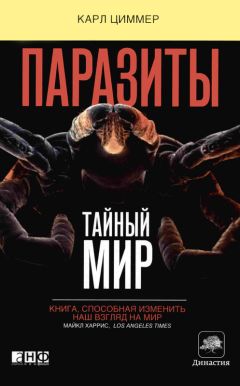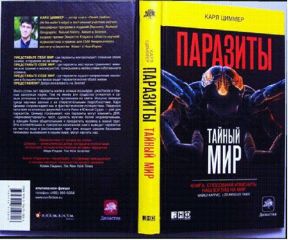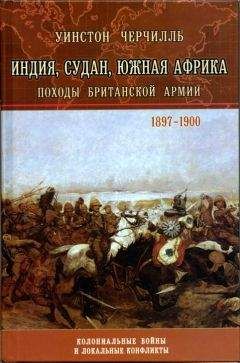Harwood, C. L., I. S. Young, D. L. Lee, and J. D. Altringham. 1996. The effect of Trichinella spiralis infection on the mechanical properties of the mammalian diaphragm. Parasitology 113:535–543.
Haseeb, M. A., N. R. Bergquist, L. K. Eveland, and R. C. Eppard. 1998. Vaccination against schistosomiasis: Progress, prospects, and novel approaches. Paper read at Ninth International Congress of Parasitology, 1998, at Chiba, Japan.
Hashimoto, T., L. B. Sanchez, T. Shirakura, M. Muller, and M. Hasegawa. 1998. Secondary absence of mitochondria in Giardia lamblia and Trichomonas vaginalis revealed by valyl-tRNA synthetase phylogeny. Proceedings of the National Academy of Sciences 95:6860–6865.
Heinlein, R. A. 1990. The puppetmasters. New York: Ballantine Books.
Helluy, S., and J. C. Holmes. 1989. Serotonin, octopamine, and the clinging behavior induced by the parasite Polymorphus paradoxus (Acanthocephala) in Gammarus lacustris (Crustacea). Canadian Journal of Zoology 68:1214–1220.
Herre, E. A. 1993. Population structure and the evolution of virulence in nematode parasites of fig wasps. Science 259:1442–1445.
Herren, H. R., and P. Neuenschwander. 1991. Biological control of cassava pests in Africa. Annual Review of Entomology 36:257–283.
Hershokovitz, I., and G. Edelson. 1991. The first identified case of thalassemia? Human Evolution 6(1):49–54.
Hill, A. V. S., S. N. R. Yates, C. E. M. Allsopp, S. Gupta, S. C. Gilbert, A. Lalvani, M. Aidoo, M. Davenport, and M. Plebanski. 1994. Human leukocyte antigens and natural selection by malaria. Proceedings of the Royal Society of London B 346:378–385.
Hitler, A. 1971. Mein Kampf. Translated by Ralph Manheim. Boston: Houghton Mifflin Company.
Hoberg, E. P., S. L. Gardner, and R. A. Campbell. 1999a. Systematics of the Eucestoda: Advances toward a new phylogenetic paradigm, and observations on the early diversification of tapeworms and vertebrates. Systematic Parasitology 42:1–12.
_____, A. Jones, and R. A. Bray. 1999b. Phylogenetic analysis among the families of the Cyclophyllidea (Eucestoda) based on comparative morphology, with new hypotheses for co-evolution in vertebrates. Systematic Parasitology 42:51–73
_____, R. L. Rausch., K. Eom, and S. L. Gardner. 2000. A phylogenetic hypothesis for species of the genus Taenia (Cyclophyllidea: Taeniidae). Journal of Parasitology, in press.
Høeg, J. T. 1985a. Cypris settlement, kentrogon formation and host invasion in the parasitic barnacle Lernaeodiscus porcellanae (Muller) (Crustacea: Cirripedia: Rhizocephala). Acta Zoologica 66:1–45.
_____. 1985b. Male cypris settlement in Clistrosaccus paguri Lilljeborg (Crustacea: Cirripedia: Rhizocephala). Journal of Experimental Marine Biology and Ecology 89:221–235.
_____. 1987. Male cypris metamorphosis and a new male larval form, the trichogon, in the parasitic barnacle Sacculina carcini (Crustacea: Cirripida: Rhizocephala). Philosophical Transactions of the Royal Society of London B 317:47–63.
_____. 1992. Rhizocephala. In Microscopic anatomy of invertebrates. New York: Wiley-Liss.
_____. 1995. The biology and life cycle of the Rhizocephala (Cirripedia). Journal of the Marine Biological Association of the United Kingdom 75:517–550.
Hölldobler, B., and E. O. Wilson. 1990. The ants. Cambridge: Harvard University Press.
Hotez, P., J. Hawdon, and M. Cappello. 1995. Molecular mechanisms of invasion by Ancyclostoma hookworms. In Molecular approaches to parasitology, edited by J. C. Boothroyd and R. Komuniecki. New York: Wiley-Liss.
_____, and D. J. Prichard. 1995. Hookworm infection. Scientific American 272(June):68–74.
Howarth, F. G. 1991. Environmental impacts of classical biological control. Annual Review of Entomology 36:485–509.
Huffman, M. A. 1997. Current evidence for self-medication in primates: A multidisciplinary perspective. Yearbook of Physical Anthropology 40:171–200.
Hurd, H. 1998. Parasite manipulation of insect reproduction: Who benefits? Parasitology 116(Supplement):S13–21.
Hurst, G. D. D., F. M. Jiggins, and J. H. Graf von der Schulenbeurg. 1999. Male-killing Wolbachia in two species of insect. Proceedings of the Royal Society of London B 266:735–740.
Hurst, L. D. 1993. The incidences, mechanisms and evolution of cytoplasmic sex ratio distorters. Biological Reviews of the Cambridge Philosophical Society 68:121–193.
James, A. A., and P. A. Rossignol. 1991. Mosquito salivary glands: Parasitological and molecular aspects. Parasitology Today 7:267–271.
Janeway, C. A., and P. Travers. 1994. Immunobiology: The immune system in health and disease. London: Current Biology, Ltd.
Jarolim, P., J. Palek, D. Amato, K. Hassan, P. Sapak, G. T. Nurse, H. L. Rubin, S. Zhai, K. E. Sahr, and S. Liu. 1991. Deletion in erythrocyte band 3 gene in malaria-resistant Southeast Asian ovalocytosis. Proceedings of the National Academy of Sciences 88:11022–11026.
Karanja, D. M. S., D. G. Colley, B. L. Nahlen, J. H. Ouma, and W. E. Secor. 1997. Studies of schistosomiasis in western Kenya: I. Evidence for immune-facilitated excretion of schistosome eggs from patients with Schistosoma mansoni and human immunodeficiency virus coinfections. American Journal of Tropical Medicine and Hygiene 56(5):515–521.
Karban, R., and G. English-Loeb. 1997. Tachinid parasitoids affect host plant choice by caterpillars to increase caterpillar survival. Ecology 78:603–611.
Katz, L. A. 1998. Changing perspectives on the origin of eukaryotes. Trends in Ecology and Evolution 13:493–497.
Kavaliers, M., and D. Colwell. 1995a. Discrimination by female mice between the odors of parasitized and non-parasitized males. Proceedings of the Royal Society of London B 261:31–35.
_____. 1995b. Odors of parasitized males induce aversive responses in female mice. Animal Behavior 50:1161–1169.
Kawecki, T. J. 1998. Red Queen meets Santa Rosalia: Arms races and the evolution of host specification in organisms with parasitic lifestyles. American Naturalist 152:635–651.
Kazazian, H. H., and J. V. Moran. 1998. The impact of L1 retrotransposons on the human genome. Nature Genetics 19:19–24.
Kelley, W. E., and J. E. Atz. 1964. A pygidiid catfish that can suck blood from goldfish. Copeia (4):702–704.
Kennedy, C. R., and J. F. Guegan. 1996. The number of niches in intestinal helminth communities of Anguilla anguilla: Are there enough spaces for parasites? Parasitology 113:293–302.
Kilner, R. M., D. G. Noble, and N. B. Davies. 1999. Signals of need in parent-offspring communication and their exploitation by the common cuckoo. Nature 397:667–672.
Knoll, A. H., and S. B. Carroll. 1999. Early animal evolution: Emerging views from comparative biology and geology. Science 284:2129–2137.
Koella, J. C. 1999. An evolutionary view of the interactions between anopheline mosquitoes and malaria parasites. Microbes and Infection 1:303–308.
_____, P. Agnew, and Y. Michalakis. 1998a. Coevolutionary interactions between host life histories and parasite life cycles. Parasitology 116:S47–S55.
_____, F. L. Sorensen, and R. A. Anderson. 1998b. The malaria parasite, Plasmodium falciparum, increases the frequency of multiple feeding of its mosqutio vector, Anopheles gambiae. Proceedings of the Royal Society of London B 265:763–768.
Koga, M., A. Ning, and I. Tada. 1999. Strongyloides ratti: Migration study of third-stage larvae in rats by whole-body autoradiography after S-methinonine labeling. Journal of Parasitology 85:405–409.
Kohler, S., C. F. Delwiche, P. W. Denny, L. G. Tilney, P. Webster, R. J. M. Wilson, J. D. Palmer, and D. S. Roos. 1997. A plastid of probably green algal origin in apicomplexan parasites. Science 275:1485–1488.
Kraaijeveld, A. R., J. J. M. Van Alphen, and H. C. J. Godfray. 1998. The coevolution of host resistance and parasitoid virulence. Parasitology 116(Supplement):S29–S45.
Krasnoff, S. B., D. W. Watson, D. M. Gibson, and E. C. Kwan. 1995. Behavioral effects of the entomopathogenic fungus Entomophthora muscae on its host Musca domestica: Postural changes in dying hosts and gated patterns of mortality. Journal of Insect Physiology 41(10):895–903.
Kuris, A. M., and K. D. Lafferty. 1994. Community structure: Larval trematodes in snail hosts. Annual Review of Ecology and Systematics 25:189–217.
Kyriazakis, I., B. J. Tolkamp, and M. R. Hutchings. 1998. Toward a functional explanation for the occurrence of anorexia during parasitic infections. Animal Behavior 56:265–274.
Lafferty, K. D. 1992. Foraging on prey that are modified by parasites. American Naturalist 140:854–867.
_____. 1993a. Effects of parasitic castration on growth, reproduction and population dynamics of the marine snail Cerithidea californica. Marine Ecology Progress Series 96:229–237.
_____. 1993b. The marine snail, Cerithidea californica, matures at smaller sizes where parasitism is high. Oikos 68:3–11.
_____. 1997a. The ecology of parasites in a salt marsh ecosystem. In Parasites and pathogens: Effects on host hormones and behavior, edited by N. E. Beckage. New York: Chapman & Hall.
_____. 1997b. Environmental parasitology: What can parasites tell us about human impacts on the environment? Parasitology Today 13:251–255.
_____, and A. M. Kuris. 1996. Biological control of marine pests. Ecology 77(7):1989–2000.
_____, and K. Morris. 1996. Altered behavior of parasitized killifish increases susceptibility to predation by bird final hosts. Ecology 77(5):1390–1397.
Lankester, E. R. 1890. Degeneration: A chapter in Darwinism. In The advancement of science: Occasional essays and addresses. London: Macmillan.
Lauer, S. A., P. K. Rathod, N. Ghori, and K. Haldar. 1997. A membrane network for nutrient import in red cells infected with the malaria parasite. Science 276:1122–1125.
Lavine, M. D., and N. E. Beckage. 1996. Temporal pattern of parasitism-induced immunosuppression in Manduca sexta. Journal of Insect Physiology 42(1):41–51.
Law, R. 1998. Symbiosis through exploitation and the merger of lineages in evolution. Proceedings of the Royal Society of London B 265:1245–1253.
Leptak, C. L., and J. H. McKerrow. 1997. Schistosome egg granulomas and hepatic expression of TNF-? are dependents on immune priming during parasite maturation. Journal of Immunology 158:301–307.
Lester, J. E. 1995. E. Ray Lankester and the making of modern British biology, edited by P. J. Bowler. London: British Society for the History of Science Monographs.
Lively, C. M. 1987. Evidence from a New Zealand snail for the maintenance of sex by parasitism. Nature 328:519–521.
_____. 1996. Host-parasite coevolution and sex: Do interactions between biological enemies maintain genetic variation and cross-fertilization? BioScience 46(2):107–114.
LoBue, C. P., and M. A. Bell. 1993. Phenotypic manipulation by the cestode parasite Schistocephalus solidus of its intermediate host, Gasterosteus aculeatus, the threespine stickleback. American Naturalist 142:725–735.
Locksley, R. M., and S. L. Reiner. 1995. Murine leishmaniasis and the regulation of CD4+ cell development. In Molecular approaches to parasitology, edited by J. C. Boothroyd and R. Komuniecki. New York: Wiley-Liss.
Lorenz, K. 1989. The waning of humaneness. Translated by Robert Warren Kickert. Boston: Little, Brown and Co.
Low, B. S. 1990. Marriage systems and pathogen stress in human behavior. American Zoologist 30:325–339.
Lutzen, J., and J. T. Høeg. 1995. Spermatogonia implantation by antennular penetrations in the akentrodonid rhizocephalan Diplothylacus sinensis (Keppen, 1877) (Crustacea: Cirripedia). Zoologischer Anzeiger 234:201–207.
Lynch, N., I. A. Hagel, M. Palenque, and M. C. DiPrisco. 1998. Relationship between helminithic infection and IgE response in atopic and nonatopic children in a tropical environment. Journal of Allergy and Clinical Immunology 101:217–221.
Lythgoe, K. A., and A. F. Read. 1998. Catching the Red Queen? The advice of the rose. Trends in Ecology and Evolution 13:473–474.
MacDonald, J. F. 1995. Transposable elements: Possible catalysts of organismic evolution. Trends in Ecology and Evolution 10:123–126.
Marcogliese, D. J., and D. K. Cone. 1997. Parasite communities as indicators of ecosystem stress. Parasitologia 39:227–232.
Margulis, L. 1998. Symbiotic planet: A new look at evolution. New York: Basic Books.
Maynard, B. J., L. DeMartini, and W. G. Wright. 1996. Gammarus lacustris harboring Polymorphus paradoxus show altered patterns of serotonin-like immunoreactivity. Journal of Parasitology 82:663–666.
Meredith, S. E. O., and H. B. Dull. 1998. Onchocerciasis: The first decade of mectizan treatment. Parasitology Today 14:472–473.
Messier, F., M. E. Rau, and M. A. McNeill. 1989. Echinococcus granulosus (Cestoda: Taeniidae) infections and moose-wolf population dynamics in southwestern Quebec. Canadian Journal of Zoology 67:216–219.
Milinski, M. 1990. Parasites and host decision-making. In Parasitism and host behavior, edited by C. J. Barnard and J. M. Behnke. London: Taylor & Francis.





